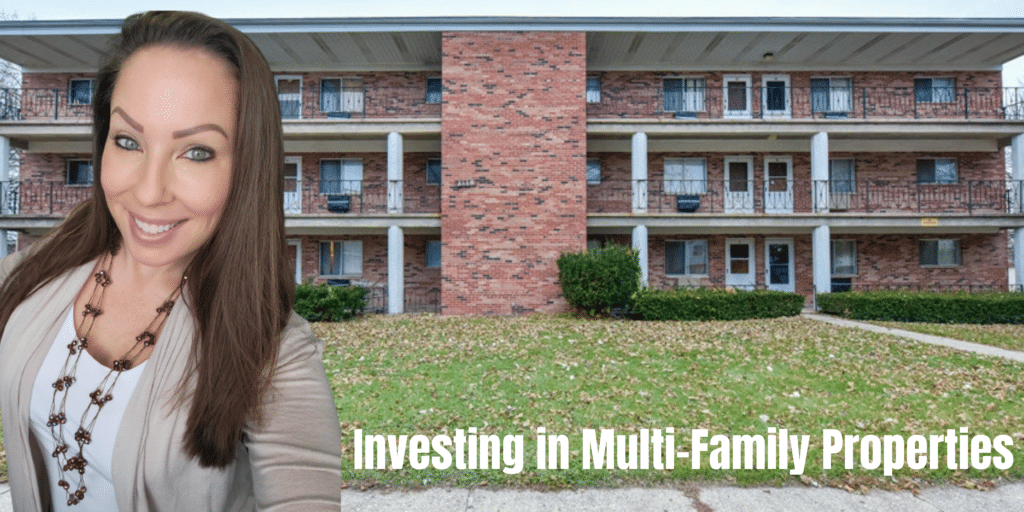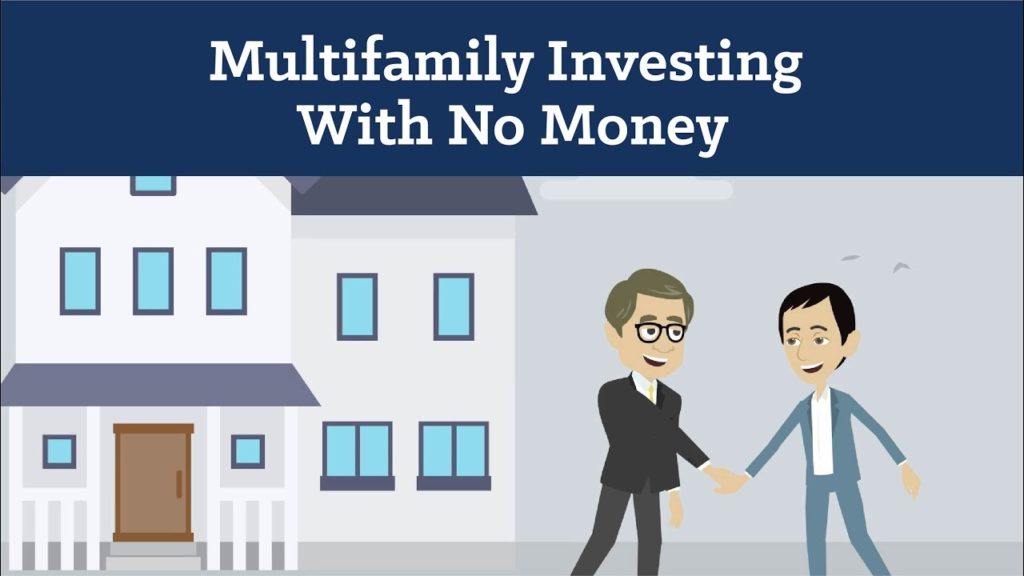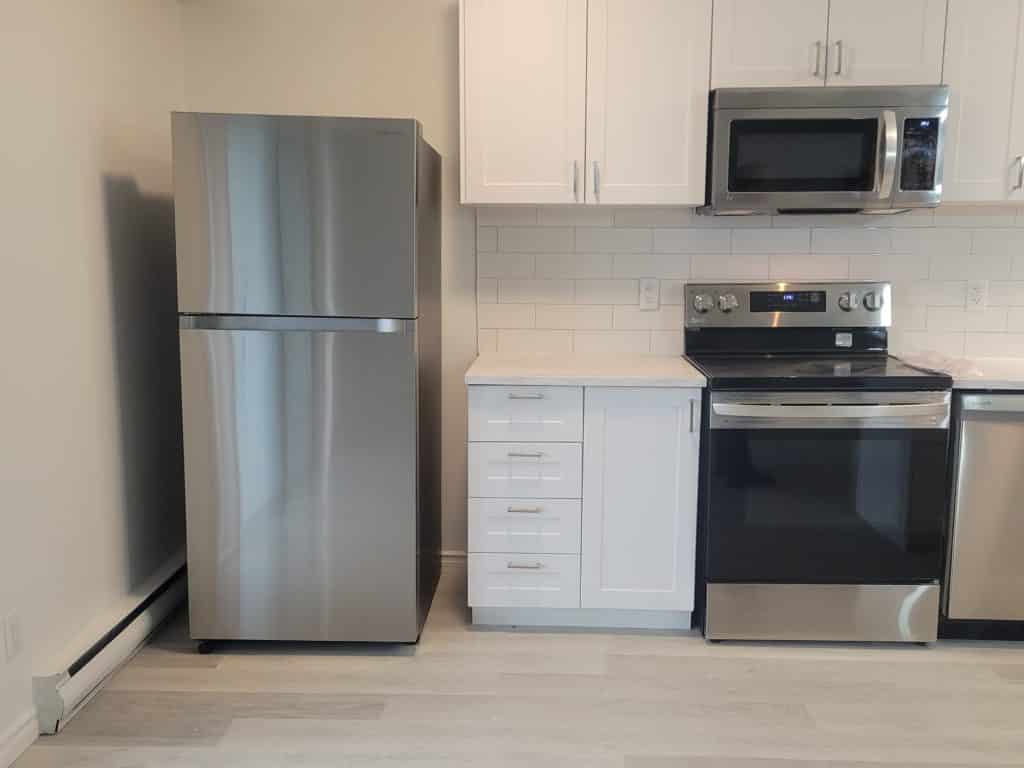
How to invest in multi-family properties.
If you’ve been investing in single family rental properties or short-term rentals, you may be interested in laddering up your investments. Or, perhaps you’d like to put money you have saved in other investments to use in fresh, new ways.
If investing in multi-family properties is something you’ve been thinking about, then this article is for you!
First off, why should should you consider investing in multi-family?
more expensive but easier to finance
What a paradox, right!
For one, it’s easier to qualify for a mortgage on a property with 6 doors or more.
Why?
Because financial institution don’t require a personal guarantee the way they do on a single-family home. As long as you have the down payment, then they are generally more concerned with the profitability of the property and net income than they are with your personal finances.
it's easier to grow quickly
If your goal is growing your portfolio, then investing in a multi-family property is the method that will allow you to do so. Buying a 20+ unit apartment building is a lot easier and far more efficient in terms of time than it is to buy 20 single family homes. There is only one property, one agreement of purchase and sale, one inspection, one mortgage. You get the idea.
it makes financial sense
If you purchase a property with many units, then vacancy may not have some of the same implications as it would on smaller property. For example, if you have 24 or 36 unit property and have a unit or two vacant, then it’s easier to absorb a month or two without a tenant. If you have a suited single-family home or a duplex and one of the two spaces.
In addition, when it comes to the actual management of the property, it’s easier to have all of the units in the same physical location then spread out across a larger area. I’ll get into this more below.
Now you could be wondering, “how the heck am I supposed to afford a multi-million dollar purchase like this?”
That brings us to…
other people's money(also known as raising capital)
This sounds so crass when you say it like this, but it’s true??
If you don’t have a large enough down payment saved up, you’re in luck! Just because you don’t have any, or all of the money of your own saved up does not eliminate you from investing in multi-family properties.
In fact, I know many investors who have hundreds of “doors” and they’ve acquired them with little to none of their money.
Again…”how???” you’re likely thinking.
With the purchase of larger acquisitions, these are often structured based on a real estate investment trust, a syndication with a group of investors in a GP/LP (general partner and limited partner) structure or even by leveraging private lending by way of promissory note.
a real estate investment trust
Also, known as a REIT, this type of investment owns and/or manages income producing commercial real estate. There are five categories in total.
- Retail REIT’s – about 24% of REIT’s are in shopping malls and freestanding retail.
- Healthcare REIT’s – this involves the real estate of hospitals, medical centres, nursing facilities and retirement homes. Did you know that in Canada, retirement homes are also included in a collection of properties that are actually exempt from rent controls? When I learned this, I found it really ironic since the senior population are generally on a fixed income and more vulnerable to unexpected rental increases and inflation.
- Office REIT’s – the benefit of these are that commercial leases in offices tend to be very long, but they can also have extended vacancies when a tenant leaves.
- Mortgage REIT’s – about 10% of all REIT’s are in mortgages rather than physical real estate.
- Residential REIT’s – relative to the topic we’re discussing today, residential REIT’s own and operate multi-family rental apartment buildings as well as manufactured housing. As long as apartment supply in a market is low and demand is rising, these typically perform well.
apartment syndications
Aside from REIT’s, another model is an apartment syndication. This is an agreement between a group of investors and a general partner(the working partner) who will share in the profits of a real estate venture.
The general partner is responsible for securing the investment and managing it. To do so, they would typically charge a management or acquisition fee. Then investors provide most, if not all of the money for the real estate investment. In most cases, you may offer your investors a mix of cash flow and equity in the property. It’s also important to identify the length of their commitment and what the exit strategy will be.
promissory note
Last but not least, you could also raise money for the down payment from investors and offer them a general security agreement or promissory note. In exchange for their invesment, you would typically offer them monthly cash flow on an interest only loan for a period of time. After the end of that period, you would own them their principal back.
It’s important you run the numbers very carefully to determine how you will pay them back whether this is by improving the property and refinancing, relying on market conditions to improve etc. Since these are ‘unsecured loans’, they are percieved as considerably more risky which means the general expectation is a much higher interest rate of 14-18%.
For far more detail on strategies to invest in multi-family properties with none of your own money, here is a great article on FortuneBuilders.com.
Now that you have a general idea of where the money could be coming from if you don’t have the appropriate down payment saved yourself, let’s take a look at the actual process of investing in multi-family properties.
I had the the privilege of going on a property tour of a 36-unit multi-family property just 90 minutes east of Toronto with a couple of people who are in a real estate investing mastermind i’m part of.
Introduce – Ray and Rosanne.
They have partnered on five mid-sized multi-family property acquisition properties over the past three years and have lofty goals of acquiring many more in the coming years.
With regards to the property i had the chance to see, they came across it earlier this year and only had a day to decide if they wanted to put in an offer. The property was built in 1970’s and although yes, it was cash-flowing a bit it was an older property. This provides the opportunity to improve the value, as well as to increase cash flow through efficiencies.
Before I get into all of that, let’s first go over the offer process.
After evaluating the property, Ray and Rosanne put in an offer at asking price which was accepted and the deposit was issued. Next some of the REAL work began!
due diligence
If you’re investing in multi-family properties, it’s extremely important to give yourself adequate time (and a cushion if you can) to conduct all of the due diligence required.
In this case, the agreement of purchase and sale was written in such a way that the 30 business days provided for the due diligence process didn’t start ticking until the seller turned over all of the important documents. These would include things such as leases, rent rolls, accounting reports (profit and loss/balance sheets), and more.

With all of this information in hand, the onus was now on Ray and Rosanne to go over the details with their lawyer and accountant to ensure everything that was provided met their expectations and ultimately, their needs.
When you’re investing in multi-family properties, there are far greater risks, liabilities and chances for things to go awry so it’s wise to conduct due diligence thoroughly with your trusted team of advisors.
In addition to financials, another huge part of due diligence when you’re investing in multi-family properties is the inspection. This isn’t generally something you want to organize until the seller has passed over their documents to you because this is the step in the process when it will start to cost you money.
Just like in single family residential, you’ll need to conduct an inspection. In this case, since Ray and Rosanne had to review a much larger property, with 36 units, you can imagine that the time and cost to complete this is significantly more. The average cost for a standard home inspection if $500+/-. For a mid-size multi-family of this size, you could be looking at $2,500-$3,000+ depending on the area.

In addition to the inspection, you also need to have an environmental inspection done. This can happen in 3 phases, but I’ll warn you that you generally never want to proceed past phase 1. It’s costly to conduct and usually means there could be high remediation costs to bring the property up to where it needs to be.
If you’re buying the property for “a steal” then maybe this is a cost you’re willing to absorb as it could be offset by the cost of the property itself if you’re getting it for a reduced price – but, that is a decision you’ll need to approach cautiously.
On this same day, you should also have an appraiser with you.
It’s important that the value of the property comes in at or above what you’ve offered to pay for it. If it comes in lower, then you may need to try to find a way to fund the difference between your down payment and what the bank is willing to cover. It’s never a good idea to find yourself in this position.
If the property has passed these inspections and the appraisal favourably, then you can proceed comfortably with financing.
Between the inspections and appraisal, depending on the size of the property, you could be looking at $10,000 +/- so you don’t want to go this deep into the process if you have any uncertainty about the property at all.
financing
As mentioned earlier in the article, you may not necessarily have a couple million dollars to spare to invest in a multi-family property. But, you may have 10 contacts all willing to invest $100,000+ to provide you with enough of a down payment to do so.

If you’re brand new to real estate investing, I would urge you to seek out other investors who have done this before so you can get help understanding how to structure this kind of arrangement, the legalities to protect your investors as well as yourself, and to strategize a plan of how investors will be paid (i.e. monthly interest, equity and/or both). You also need to iron out the terms of the agreement and what the exit strategy will be. This could be a three-year or five-year term with the opportunity for investors to cash out at that time.
In many cases, investors are planning to renovate as many units as they can so the property can re-appraise at a higher value, they can raise the rents and re-finance to take the increased equity out. I’ll get into this in a little more detail below.
In Ray and Rosanne’s case, they gave themselves 90 days to raise the capital required for the down payment then they traditionally funded the rest. They spoke to a total of 4 lenders and managed to secure one based on 80% loan to value over a 3 year term. This was the best offer they could get, with others coming in as high as 60% loan to value (this means they’d need a 40% down payment!).
When you’re calculating your numbers, it’s wise to be conservative and keep in mind the time frame of any potential larger jobs or unforeseen expenses that could be required onsite.
I’m sure rising interest rates weren’t necessarily on everyone’s mind at the beginning of this year, but it’s a hard cost that every property owner on a variable mortgage has been grappling with. You always want to make sure you have a cushion to cover anything that could come up, expected or otherwise.
improvements
In addition to the down payment, Ray and Rosanne also had to come up with a plan to cover the cost of required renovations, an investment they calculated would raise the value of the property by more than 30%.
In Ontario, the Landlord Tenant Board has extremely tight regulations and generally favours tenants. Just because you have purchased a rental property, doesn’t mean you have the right to evict a tenant.
As such, if you’d like to make improvements, a common strategy is a “cash for keys approach” and an N11. This means you’re essentially offering a tenant a favourable cash amount in exchange for their agreement to vacate the unit.
This gives you the opportunity to invest in renovations and bring in a new tenant at a higher price point which will earn you more in the long run. A one bedroom unit that is renting for $1,200/mth could easily be renovated and re-rented for $1,800/mth in this particular area.
It’s important to keep in mind that tenants do not have to accept this and have the right to stay. More than likely, some will probably stay, even if they are offered several thousands of dollars to leave. Conservatively, you can likely estimate that you’ll be able to turn over 70-80% of tenants with this approach and others, you’ll simply have to wait out until they decide to leave.
In terms of the work itself…
When you’re working with contractors, it’s important to develop a detailed checklist and budget for any renovations that have to happen. This will keep you and your contractor on the same page and help you streamline any efficiencies so nobody is going back and forth unnecessarily.
If you can buy anything in bulk, such as flooring, cabinets or appliances, that is also ideal. Just make sure you’ve got secure storage if you do have an overflow of any materials to hang on to while units are being turned over.

Another opportunity to make money is by finding efficiencies.
If units are not separately metered, then tenants can’t be billed for utilities directly. As such, there is no choice but to include them in the rent.
As you can likely appreciate, on a 36-unit property, utilities can be extremely high. And, for tenants that aren’t seeing the monthly costs, they may not be as responsible about managing those utilities.
They could be jacking up their baseboard heaters and leaving windows open at the same time, in the dead of winter.
Along with renovations, bringing in individual meters for the units can lead to a huge cost savings in the long run, even if there is a bit of a larger price tag to get them done.
If you’re shutting off power for any extended period of time, especially in the winter, you’ll be able to be very careful that the work can be done in a short period of time (i.e between 9am-5pm). If it runs longer, you could be faced with putting tenants up in a hotel over night and even reimbursing them for food, replacing food etc.
management
I’m sure we can both agree that managing and maintaining a property of this size isn’t an easy job and one that you won’t want to tackle alone. It’s a good idea to have an onsite superintendent to maintain the grounds and respond to smaller inquiries, repairs etc.
For any larger jobs and for managing tenant issues, executing leases etc., then you’ll want to make sure you have a solid property management company.

When you invest in multi-family properties, or really any rental property, it’s a wise idea to take a “hands off” approach. This doesn’t mean you’ll never stop by the property but if you are there, it may be best that you keep to yourself, don’t introduce yourself as the owner and don’t give tenants any personal information about yourself.
I know this may sound a little crazy but given the way the landlord tenant laws are, at least here in Ontario, this may be helpful to protect yourself in the unforeseen situation that you’re dealing with an unruly tenant.
Surround yourself with a great team and you won’t have to worry about this!
passive investment opportunities
If you’re interested in invesing in a multi-family property, but maybe you’re just not ready to take the leap on your own just yet, that’s OK. There are also PLENTY of passive opportunities out there for accredited investors as well.
Not sure what it means to be accredited?
An accredited investor is an individual, entity, or financial institution with a special financial status that enables them to invest in opportunities that are not available to the public market. The official definitely has 22 categories, but from an individual perspective, the Canadian Securities Commission have outlined that this means that must have any of the following:
- You have income of $200,000+, before tax, for at least two years in a row, or $300,000 when combined with a spouse.
- You, or you with a spouse, must have net assets of at least $5,000,000.
- You must also have aggregate financial assets of $1,000,000 yourself or jointly with a spouse. This could be cash, stocks, bonds etc.
- You are registered in Canada, under securities legislation, as a dealer or an adviser.
If you don’t meet these criteria, this doesn’t mean that you can’t invest in anything at all. There are still opportunities to invest in real estate mortgages, mortgage investment corporations (aka “MIC’s), crowdfunding, and more.
If you DO meet this criteria however, and you’re interested in learning more about opportunities to invest in a multi-family property such as the one that Ray and Rosanne are working on, please touch base. I can be reached at 647-896-6584, by email at info@serenaholmesrealtor.com or by going to https://serenaholmesrealtor.com/contact/
And of course, if you are interested in investing in multi-family properties, I’d love to help you find one so you can start building a portfolio to support your financial future and the lifestyle you desire.
For plenty of other great tips, info and news, make sure we’re connected on social at https://instagram.com/serenaholmesrealtor











